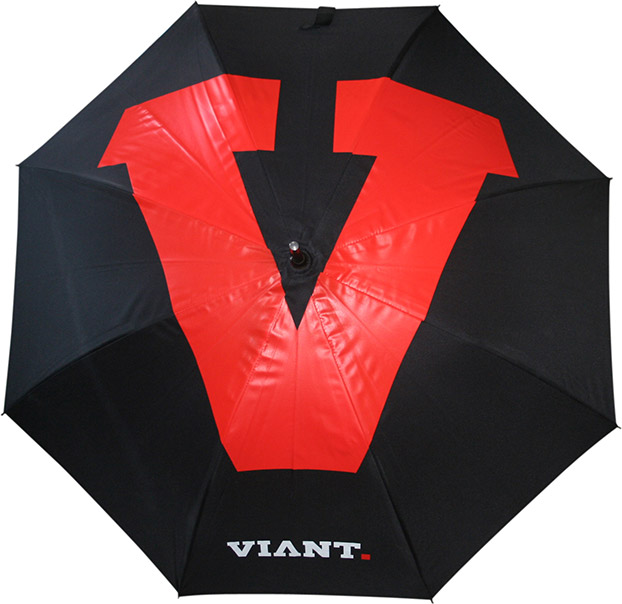We take umbrellas for granted as handy accessories that protect us from the rain (especially in the UK), but we rarely think about them when we aren’t hurriedly searching through a bag to find one, or kicking ourselves for forgetting one.
However, the humble umbrella has a very long and noble history. The word ‘umbrella’ comes from the Latin root ‘umbra’, which means shade or shadow, and there is evidence that they were in use more than 4,000 years ago in civilisations as far apart as China, Greece, Egypt and Assyria. The Chinese were the first people to wax or lacquer paper umbrellas in order to use them in the rain, and they started to become popular in the western world during the 16th and 17th century, especially as protection from the damp climates of northern Europe with which we are still so familiar.
Umbrellas are fascinating objects that we tend to use and lose with careless abandon – more than 10,000 are mislaid each year on the London Underground alone.
At Umbrella Workshop, we think it’s high time we start thinking differently about umbrellas and how they can be a bigger part of our lives, rather than just an afterthought that we only think about when it starts to rain. Here then, are our 5 unusual ways to use an umbrella.
1. As a Sun Shade
The original use for an umbrella was as a sunshade, rather than as protection from wet weather. Ancient Egyptians constructed shades from feathers, palm fronds and stretched papyrus, which were attached to chariots or held over the heads of royalty by servants.
Noblewomen in ancient Greece had female slaves carry parasols to protect them from the hot Mediterranean sun, but also as fashion accessories too.
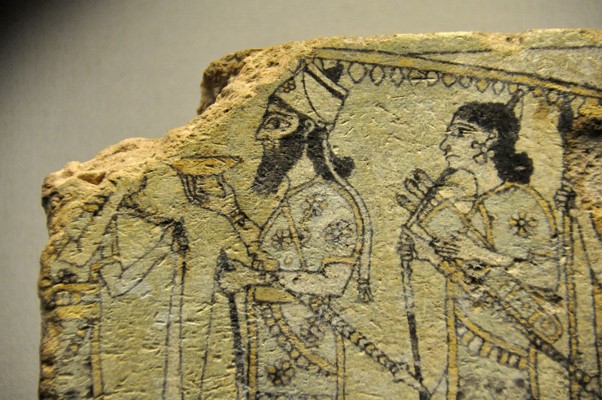
Assyrian king beneath a parasol. Source: Wikimedia Commons
Using your umbrella as protection from the sun is an excellent idea, especially if you’re in an area that doesn’t offer shade from trees or buildings, such as at the beach or in open countryside. As well as stopping you from getting too hot, staying in the shade helps to prevent you getting sunburn, which isn’t only extremely uncomfortable but can lead to very serious conditions such as skin cancer.
Whilst a colourful umbrella might feel like a more summery choice, a black one is actually best as it absorbs the heat and keeps you cool beneath it.
2. Using an Umbrella as a Decoration
As well as having many practical uses, umbrellas are also aesthetically pleasing and therefore ideal for decorating a space. They are especially useful for decorating big events, such as parties and wedding venues, due to their eye-catching appearance. A large number of umbrellas hung from the ceiling have a dramatic effect, especially if you use a series of vibrant colours or designs.

Image source: cmd-ks.biz
Umbrellas are also particularly useful for decorating outside events, because, by their very nature, they are sturdily built for outdoor use, and won’t be ruined by wet weather. Hung from trees or suspended on wires above a street or courtyard, they look fantastic, are super practical and can be used again and again.
3. Using an Umbrella as Part of a DIY Photography Studio
If you have ever been in a photography studio, you will probably have seen an umbrella in use as part of the photographer’s equipment. Umbrellas help photographer’s to create professionally lit images by diffusing light and giving it a softer effect. Instead of allowing light to focus directly on a subject, an umbrella bounces the light off in different directions. This results in a clearer image with softer shadows, or no shadow at all.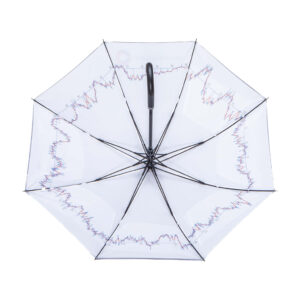
A white umbrella is the best choice for achieving a softer glow when taking photos indoors. The light source should be directed through the umbrella, which disperses the light and gets rid of dark, harsh shadows on or created by the subject. A black/silver umbrella (black on the outside/silver on the inside) brightens a subject and is usually used outdoors.
You can use any white umbrella for photography, but a black/silver one will have to be purchased from a specialist photography shop.
4. Turning an Umbrella into a Kite
Few things appear more useless than a broken umbrella. It’s estimated that more than 1 billion umbrellas are thrown away each year, which is a terrible waste of the planet’s resources.
But what can be done with a broken umbrella beyond flinging it in the bin?
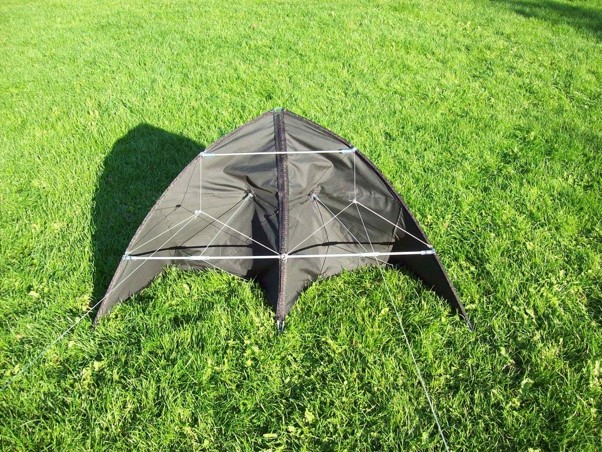
Image source: Instructables
Well, you just need to use a bit of creative thinking to find ideas for using your umbrella beyond its original purpose. One such ingenious idea is to turn it into an impressive and incredibly aerodynamic Delta kite.
Using materials that can easily be gathered from around or home or cheaply purchased, including a bent bicycle wheel, string, elastic bands, aluminium pipes and, of course, your broken umbrella, you can follow these simple instructions to turn it into an amazing flying machine. With a bit of DIY, you’ll be soaring your recycled umbrella in the wind like a modern day Mary Poppins (although let’s hope you keep your feet firmly on the ground).
5. Make a Garden Umbrella Planter
If your enthusiasm is a little more earthbound, your old umbrellas can also be used to spruce up your garden. Place an upturned, open umbrella on the ground and fill with soil, ideally a type that drains well and isn’t prone to puddling or pooling. In the soil, plant varieties of annual flowers that don’t require lots of root depth, such as sedum, petunias, geraniums, marigolds or begonias, then wait for them to bloom.

Image source: Pinterest
Umbrella garden planters are perfect for people with small outdoor spaces or those living somewhere temporarily, as they’re very easy to set up and take away, and don’t require garden beds. Using brightly coloured umbrellas that compliment the hues of your flowers can create a beautiful and vibrant garden quickly and cheaply.
Passive Resistance & Active Defence
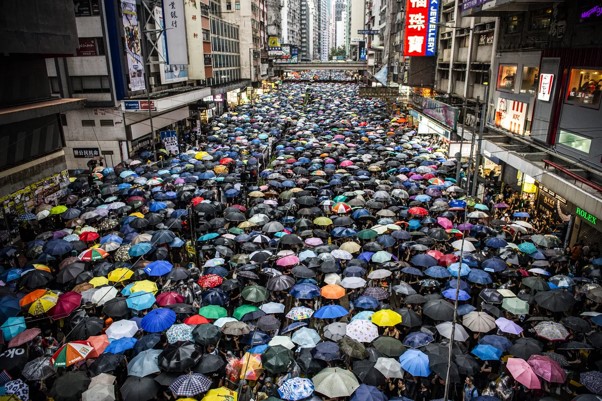
Image source: Vox
Of course this isn’t a definitive list and umbrellas have seen many other uses throughout history. One such use that in modern times that has really seen the umbrella become a symbol of resistance is the usage of umbrellas in the Hong Kong pro democracy protests. Seen as a symbol of protection and shelter, the thousands of umbrellas we’ve seen on our screens, as Hong Kong has endured months of protest, have seen the umbrella become the defining symbol of the movement and a powerful symbol of resistance to anti-democratic rule.
Umbrellas aren’t just symbolic forms of resistance either, as the French Presidential Protection Unit will very well know. These highly trained personnel all carry a ParaPactum umbrella which is a custom made protection device that can withstand thrown heavy objects, knife attacks and also be used for crowd control. Oh and it’s also useful for keeping you dry in the rain as well.
Conclusion
On a more practical note and closer to home, the umbrella can present a multitude of uses. Thinking outside of the box can breathe new life into an umbrella, whether it’s been bashed to bits by the wind, or you have lost and found so many of them that you have lots of spares on your hands. If you start thinking about your umbrella as something other than a device to keep you dry, you’ll soon find ways to use it all the time instead of just saving it for a rainy day.
In 21st century Britain we largely view umbrellas as wholly practical items that protect us from the rain. They are also very disposable things in the modern age, with an depressing 1.1 billion umbrellas thrown away worldwide each year.
It wasn’t always this way though. The umbrella has a very noble past, starting out as a parasol to protect people from the sun in Ancient Egypt. The earliest known are seen in Egyptian art dating back to the Fifth Dynasty, around 2450 BC. The Egyptians used umbrellas both for practical and ornamental purposes, with many temple wall paintings and reliefs showing a servant holding a parasol over a god during a procession.
Due to the expense and expertise needed to manufacture them in ancient times, umbrellas and parasols became objects of power and status, and were used to protect important people such as gods, royalty and religious leaders (a world away from their current ubiquity). This led to many religions adopting parasols and umbrellas as part of their ceremonies.
In this article we’ll take a closer look at how the different religions have used umbrellas in the past and right up to the present day.
Ancient Greece
The people of Ancient Greece believed in multiple deities (polytheism), and umbrellas featured in ceremonies devoted to several different gods and goddesses.
During the festival of the Skirophoria, which marked the end of the old year in May or June, a white parasol was carried from the Acropolis to the Temple of Phalerus by the priestesses of goddess Athena. White parasols were also associated with gods Demeter and Persephone, who represented the harvest, and they were also used when praying to the gods of fertility.
Brightly coloured umbrellas were carried by followers of Dionysus, god of wine and pleasure, in festivals and processions. This may have led to their popularity with women as tools for mating rituals – to either flirt with or ward off men – and then as a fashion accessory. Umbrellas that could open and close were mentioned in the writings of comic playwright Aristophanes who lived during the 5th century BC.
Oriental Orthodox Churches
The Oriental Orthodox Churches are a group of Christian churches that have between 60 and 70 million members worldwide. They are some of the oldest churches in the world and have played a part in shaping the history and culture of countries including Armenia, Egypt, Eritrea, Ethiopia, Sudan and the Middle East. In some of these churches, umbrellas are carried as part of their public worship to show honour to an important person, such as a bishop, or a holy object.
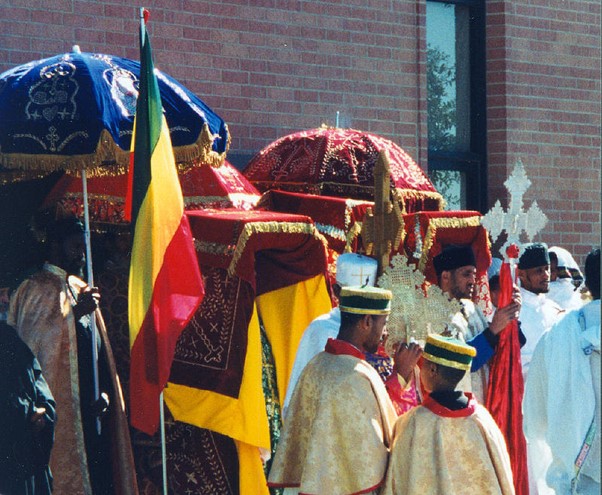
Ethiopian Orthodox clergymen lead a procession in celebration of Saint Michael. (Image source: Wikipedia)
During the Ethiopian Orthodox Tewahedo Church’s ceremonies of Timkat, a priest carries a model of the Tablets of Stone (inscribed with the Ten Commandments) called a Tabot on his head. Brightly coloured and richly fringed liturgical parasols are carried above the Tabot as the priest processes to a body of water for it to be blessed.
Buddhism
Umbrellas and parasols play an important part in the symbolism of Buddhist beliefs. The umbrella represents the dome of the sky, which casts a protective shadow onto the earth. When an umbrella is carried above an important person or a symbol of a deity, it shows that the person or symbol is the centre of the universe, and indicates that they deserve respect. The pole of the umbrella symbolises the ‘axis mundi’, or celestial pole, which represents the connection between heaven and earth. The umbrella is so important to Buddhism that it can be considered as a mobile temple.

Ushnisha Sitatapatra the White Umbrella Deity (Image source: Lamayeshe)
One of the Buddhist deities is called Ushnisha Sitatapatra in Sanskrit, which translates as ‘The Victorious White Parasol’. The parasol she carries demonstrates her ability to protect sentient beings from diseases, natural catastrophes and other calamities. The parasol is white because the means by which she protects people is through peace and pacification. In Tibetan Buddhism, some religious dignitaries are entitled to carry silk parasols, whilst secular dignitaries can carry parasols embroidered with peacock feathers. Buddhist leader the Dalai Lama is entitled to carry both.
Hinduism
In Hinduism, the parasol is known by the Sanskrit word of ‘chatra’, and is a traditional Indian symbol of both protection and royalty. The parasol is part of a grouping of eight auspicious symbols that were traditionally used in ceremonies such as the coronation or investiture of a king.
A jewelled parasol is still used in Hindu ceremonies today and performs the ritual function of a canopy. This offers protection both practically from the heat of the sun, but also symbolically from the ‘heat’ of negative forces such as greed, lust and suffering, all of which are viewed as obstacles on the path to enlightenment.

The parasol as part of the ‘eight auspicious symbols. (Image source: Pinterest)
Catholic Church
In Ancient Rome public buildings used for the administration of justice and public assemblies were called basilicas. When Rome became Christianised around 300 AD, many of these basilicas were converted into churches, and the raised platform occupied by the judge became the altar. The term ‘basilica’ was also converted to mean a church with a special distinction, and one that could only be designated by the pope.
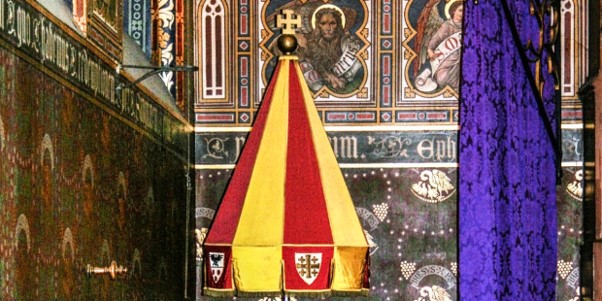
The umbraculum is a symbol of the Roman Catholic Church and the authority of the Pope (Image source: Aleteia)
The umbraculum, which translates as ‘big umbrella’ and is also known as conopaeum, is a historic part of the pope’s regalia, and was once used on a daily basis to shade him from the sun. If you see an umbraculum in a church, you’ll know it is in fact a basilica: if the umbrella is made of gold and red velvet it’s a major basilica, whilst less important ones have umbrellas made from red and yellow silk. The only time the umbraculum is opened is if the pope pays a visit.
Far from being just a simple device that keeps us dry or protects us from the sun, the umbrella has a long and fascinating history of symbolism and meaning in religious ceremony. From Ancient Greece and Rome right up to the present day, umbrellas and parasols have played an important part in ceremonies and processions within a huge variety of religions. Next time you open your umbrella to shield yourself from the rain take a moment to imagine just how important this simple device has been and continues to be throughout the world.
If you’d like to see your branding on the side of a sturdy umbrella, why not give us a call or drop us an email today to see how we can help.

Gifts are powerful. While digital may be the darling of every marketer’s eye today, branded promotional giveaways remain tried, tested, and effective. Nearly everyone will remember your business if you give them a useful freebie, like a branded umbrella or bag, according to the Advertising Specialty Institute. Trade show attendees are also more likely to think positively of your business if you give them branded items.
To truly make memorable branded gifts, you have to ensure the element that represents your brand the most–the print–is crisp and long-lasting. With the surplus of printing methods today, it can be difficult to pick one that best suits your needs. The commercial printing industry is a fast-moving field. New printing methods are constantly being developed for better, or cheaper, output.
Traditional machine printing, as its name suggests, uses specialised units to transfer the design onto the printing material. These printing lines typically consist of big, rubber rollers people often associate with printing presses. This type of printing remains the most popular and economical for big printing jobs.
Digital printing has been around for a while now but is still relatively modern compared to traditional machine printing and uses inkjet or laser printers. Prints are typically sent directly from the computer to the printer. Colours are transferred via heat and static onto the material. Digital printing is often best for jobs that require customising each print, such as for changing numbers or names.
Hand printing is the oldest form of printing out there requiring a human worker to prepare designs and manipulate tools. While obviously slower than digital or machine printing (and thus much harder to scale with automated machinery), hand-printing methods can provide more accurate results, especially if you’re printing on uneven surfaces like mugs, because workers can better manoeuvre and adjust around curves and corners.
Let’s break down some of the specific techniques that fall under these two types of printing.
Machine Printing Methods
Offset Lithography
In offset lithography, or commonly known as just “offset”, prints are transferred to a rubber rollers–typically called a “blanket”–via a metal plate burned with the design. There are typically four plates involved in the process, one each for black, cyan, magenta, and pink ink. The ink on the metal plate is imposed onto the blanket, which then transfers it onto the material.
Offset printing, while popular for printing on paper, can be too pricey for small print jobs. Machines are specially set up and plates custom-made for each job. Designs can also be difficult to change without adding to the price considerably.
Flexography
This printing technique is largely similar to offset, using a flexible rubber plate to transfer the print onto the material. The main difference is in flexography, the plate comes into contact with the printing material, whereas in offset, ink travels from the metal plate, to the blanket, then onto the material.
Flexography tends to be more versatile than offset. Offset needs flat, smooth surfaces to print on. Thanks to the flexibility of the rubber plates used in the process, you can use flexography to print on more irregularly-shaped items.
Digital Printing Methods
Direct To Garment (DTG)
Designs are directly printed onto the material using inkjet printers, and is best for materials like canvas, cotton, twill, or jersey fabric. Because designs are transferred directly from the computer, brands get to pick from a wider, more complex range of colours. This versatility makes direct-to-garment printing ideal if you’re looking to print intricate, colourful designs, or are working with soft fabric. This printing method is used for printing complex designs on umbrellas as it’s great for producing intricate detail.
While many prefer DTG, especially for t-shirt printing, it can be limited. The method doesn’t work with pure polyester materials. It can also be challenging to print vibrantly on dark fabrics using this process. Printers work around this limitation by creating a white layer for the design to sit on, although this layer can look quite noticeable if the alignment with the design is off by even a small amount.
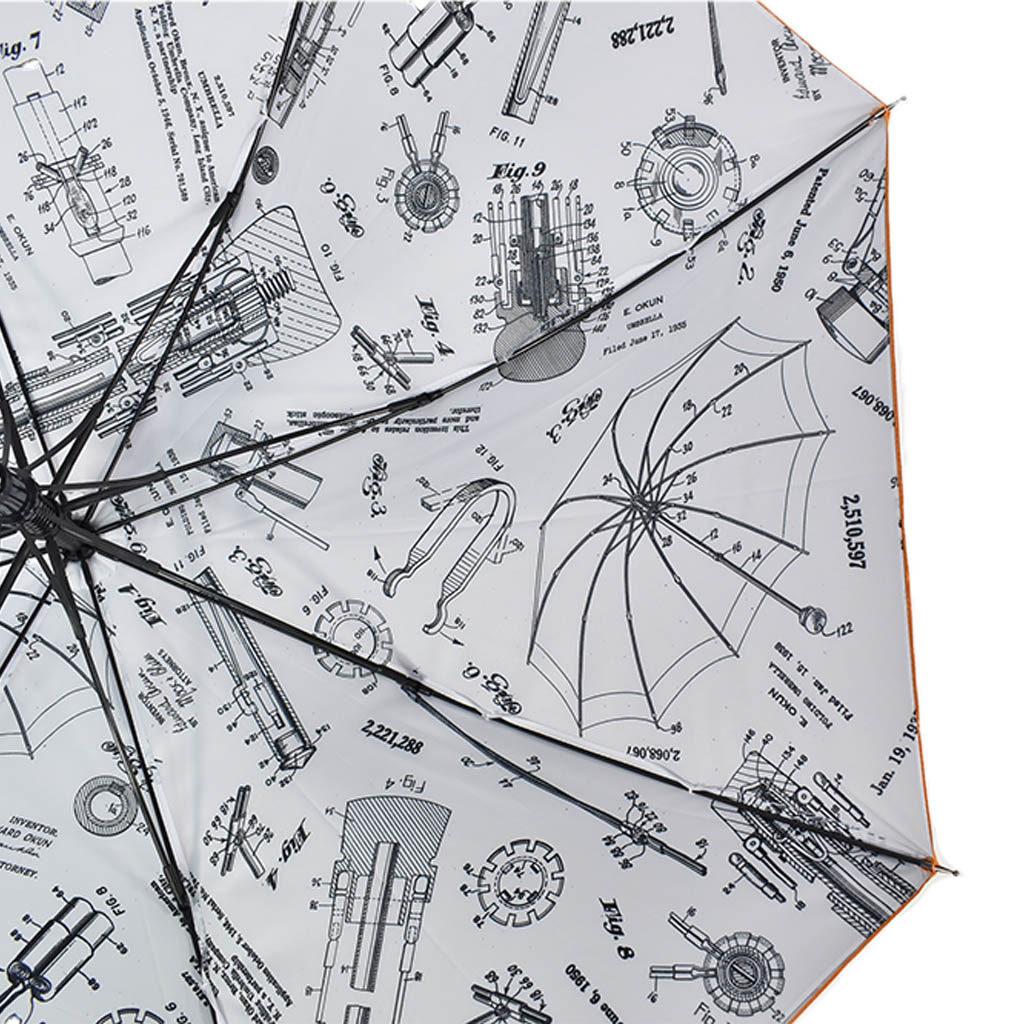
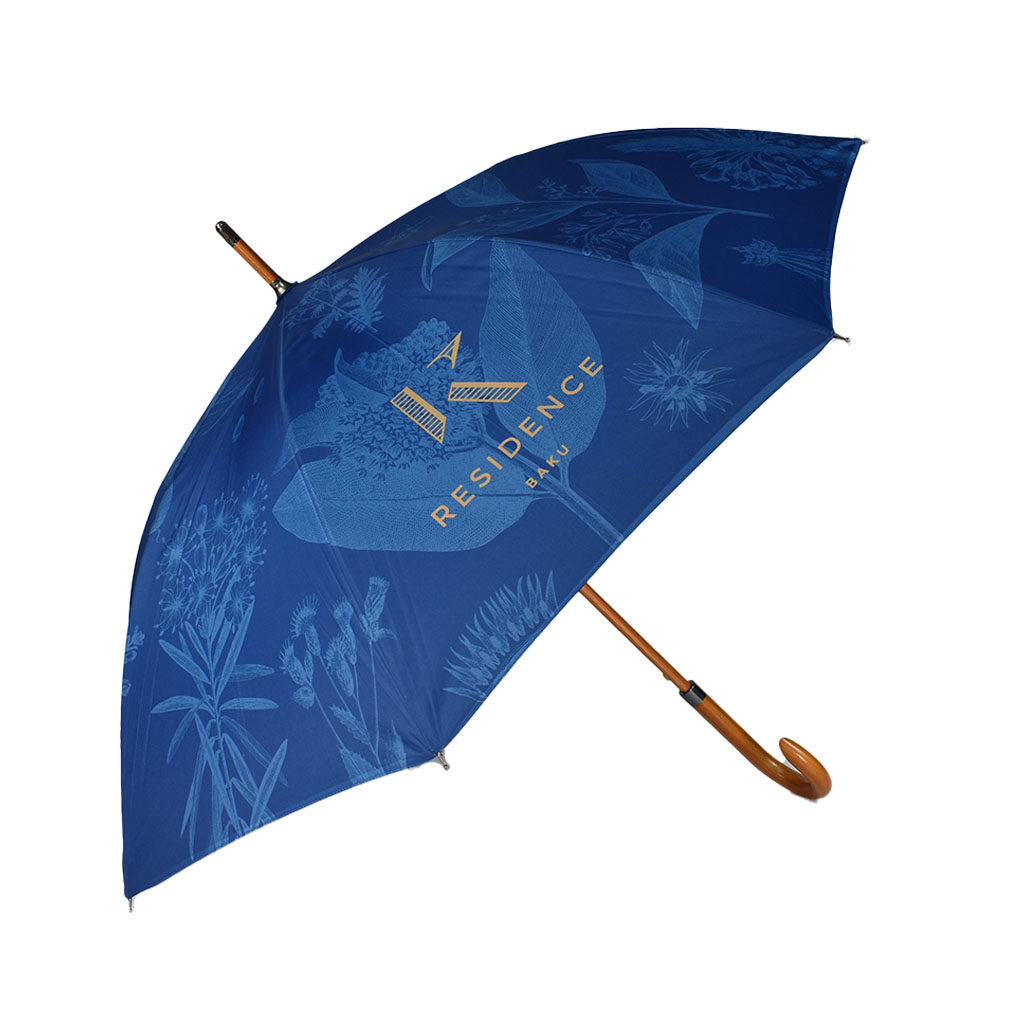
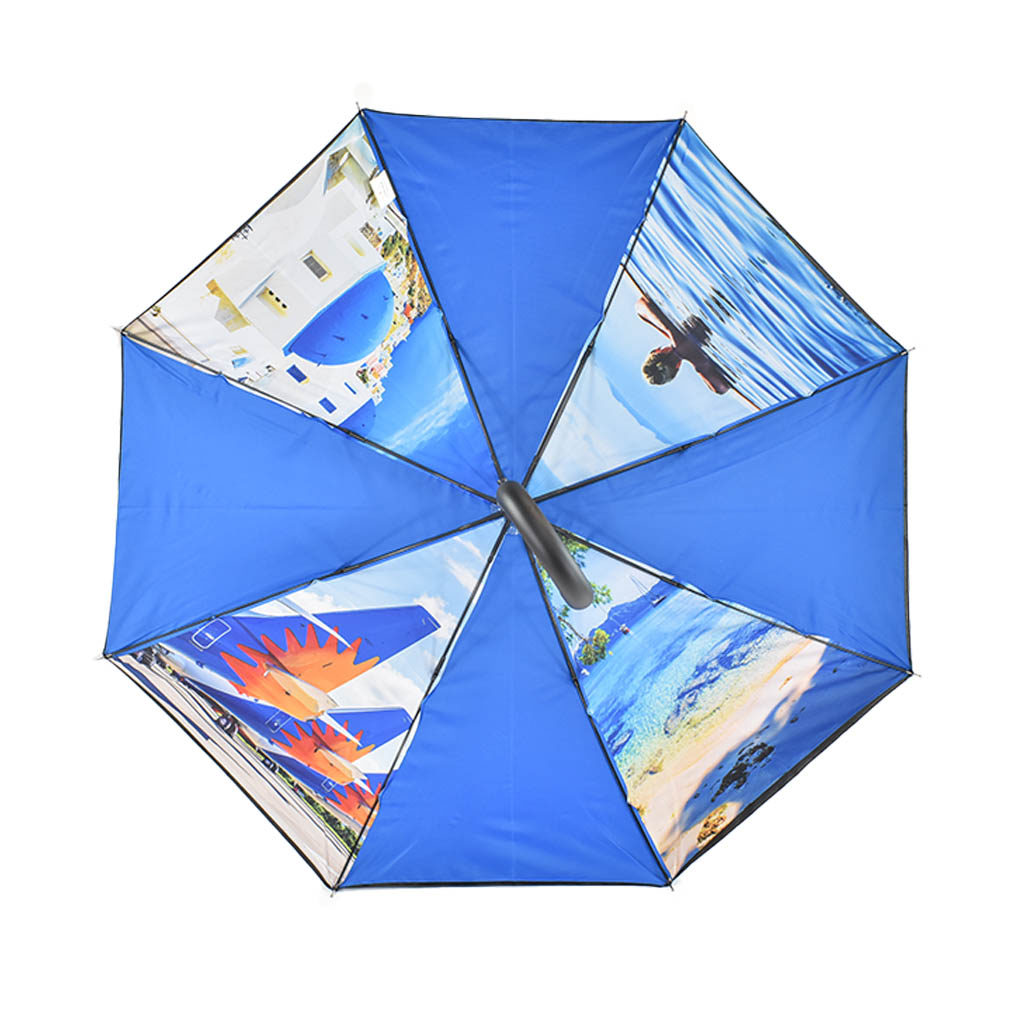


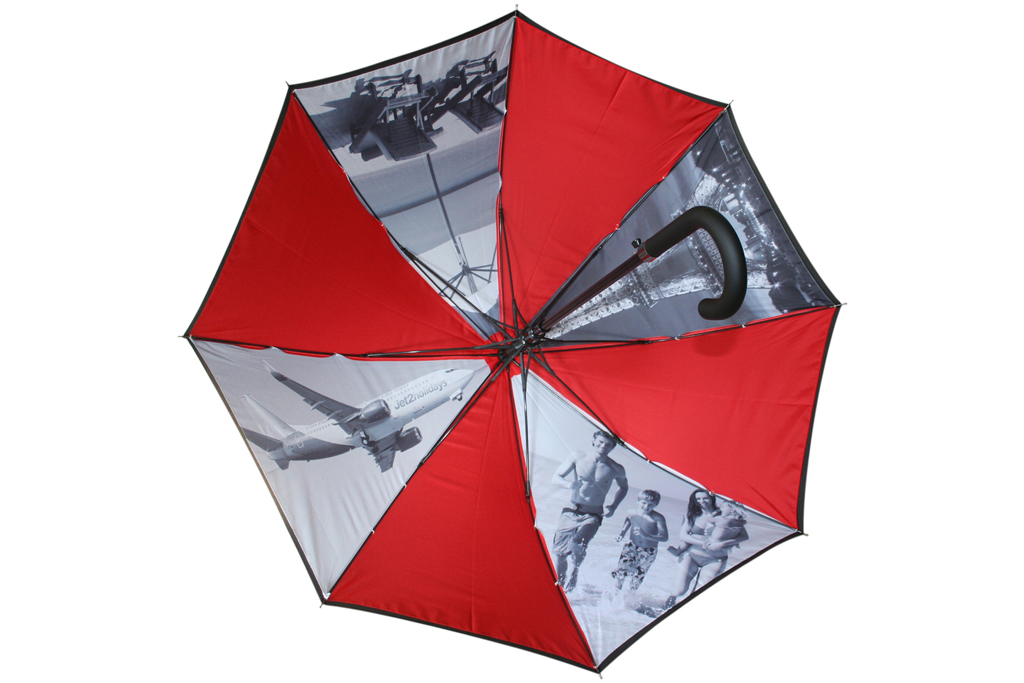

Sublimation Printing Method
Another printing method, sublimation works by printing the design on special paper called sublimation paper, then transferring it over to the material using heat. In fabric printing, sublimation is popular for its ability to transfer ink into the seams itself, instead of just layering it on top. This makes the print less likely to fade or crack over time. It is also one of the few techniques that can reliably print from edge-to-edge, which makes it ideal for brands looking to print on entire shirts or umbrellas.
The main downside of this technique is that it works only for lighter coloured polyester or polyester blend fabrics–there is no white ink for sublimation. Using cotton will make the colours look washed out, even potentially fading over time. Brands looking to print smaller designs or in smaller quantities may also save more and see the same results with DTG or screen printing.

Hand-printing methods
Heat Transfer
Heat transfer printing works similarly to decals. The design or logo is printed onto transfer paper. A machine then presses the design onto the material using pressure and heat.
This method typically costs less than offset printing, but can take longer due to the time it takes to prepare the design, which is usually cut and positioned manually by workers. The texture of the logo can also differ from the surrounding material–usually feeling more matte and looking more translucent–because the process also embosses a layer of the transfer paper onto the material.
Screen Printing
One of the oldest printing methods still widely used today, screen printing is known for its higher quality finish and versatility. It works by creating a mesh stencil of your design or logo, which is then hand-transferred to the material, then dried with a heat gun or a flash cure unit and made to set fully overnight.
Unlike most printer-based methods, you can use virtually any material: wood, smooth surfaces, fabrics, plastics. While cotton and more absorbent textiles usually work best with screen printing, there are solutions printers can use to get ink to stick better to less porous materials like nylon and polyester. This method is most commonly used for our umbrellas with logo designs or simple prints on single panels.
There’s more to the marketing power of branded giveaways than the appeal of free stuff. Items that are poorly produced reflect poorly on your brand’s commitment to quality. Choosing the right printing method for your chosen fabric or material will go a long way in ensuring your customer remembers you for quality, not cracked or faded designs.
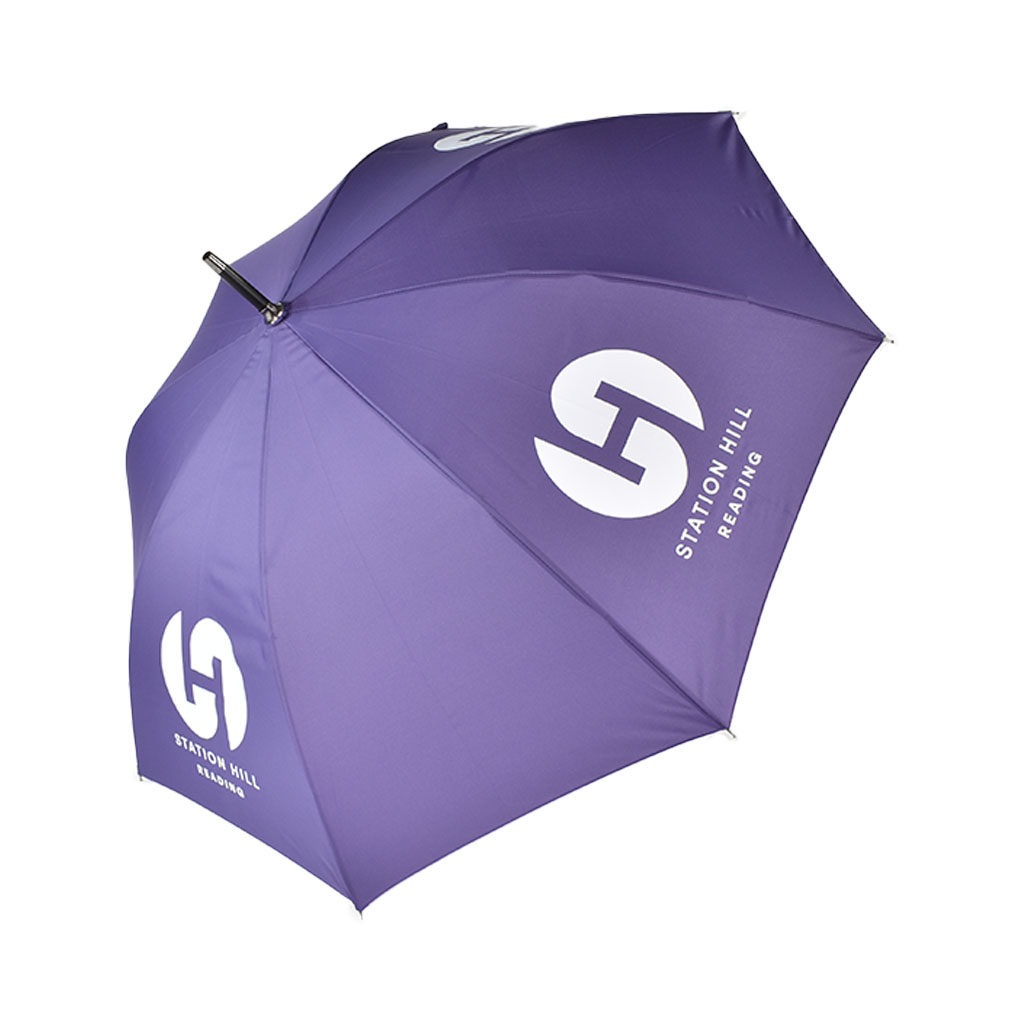

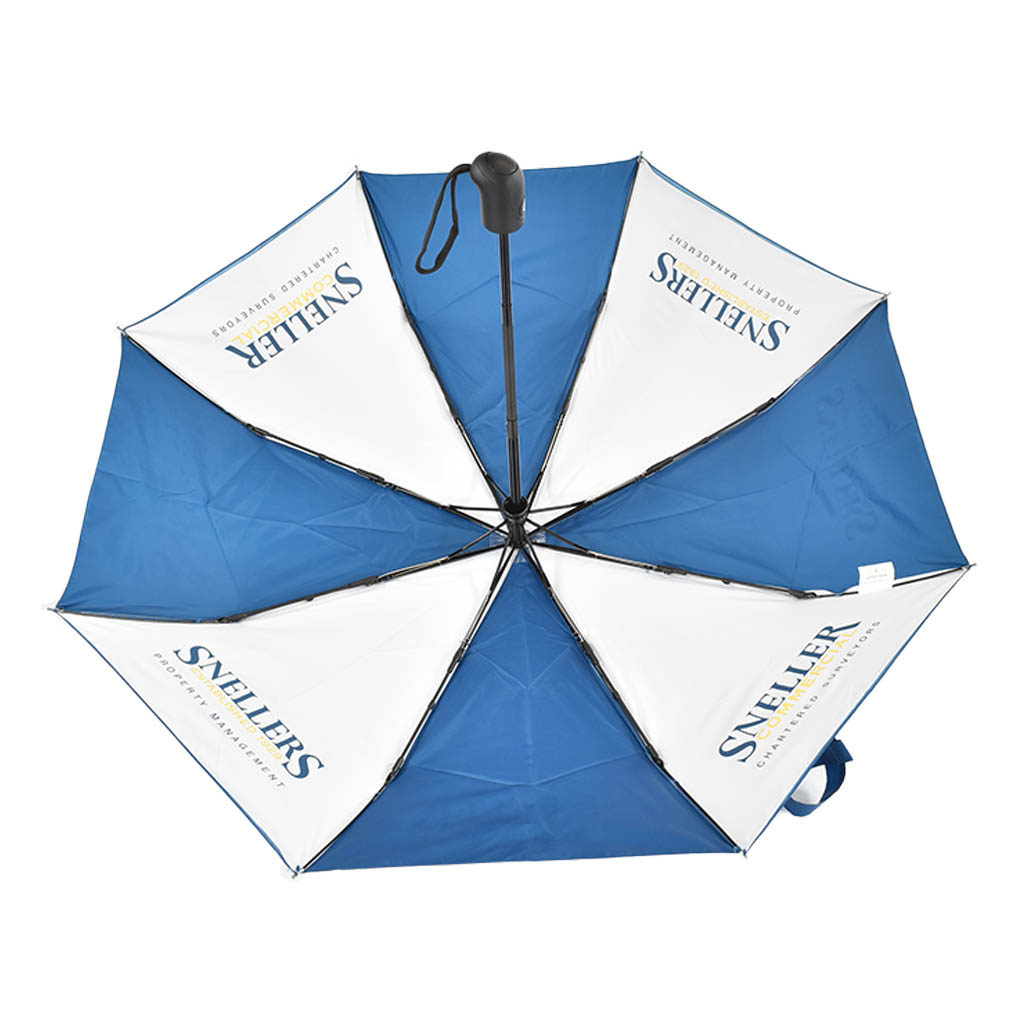

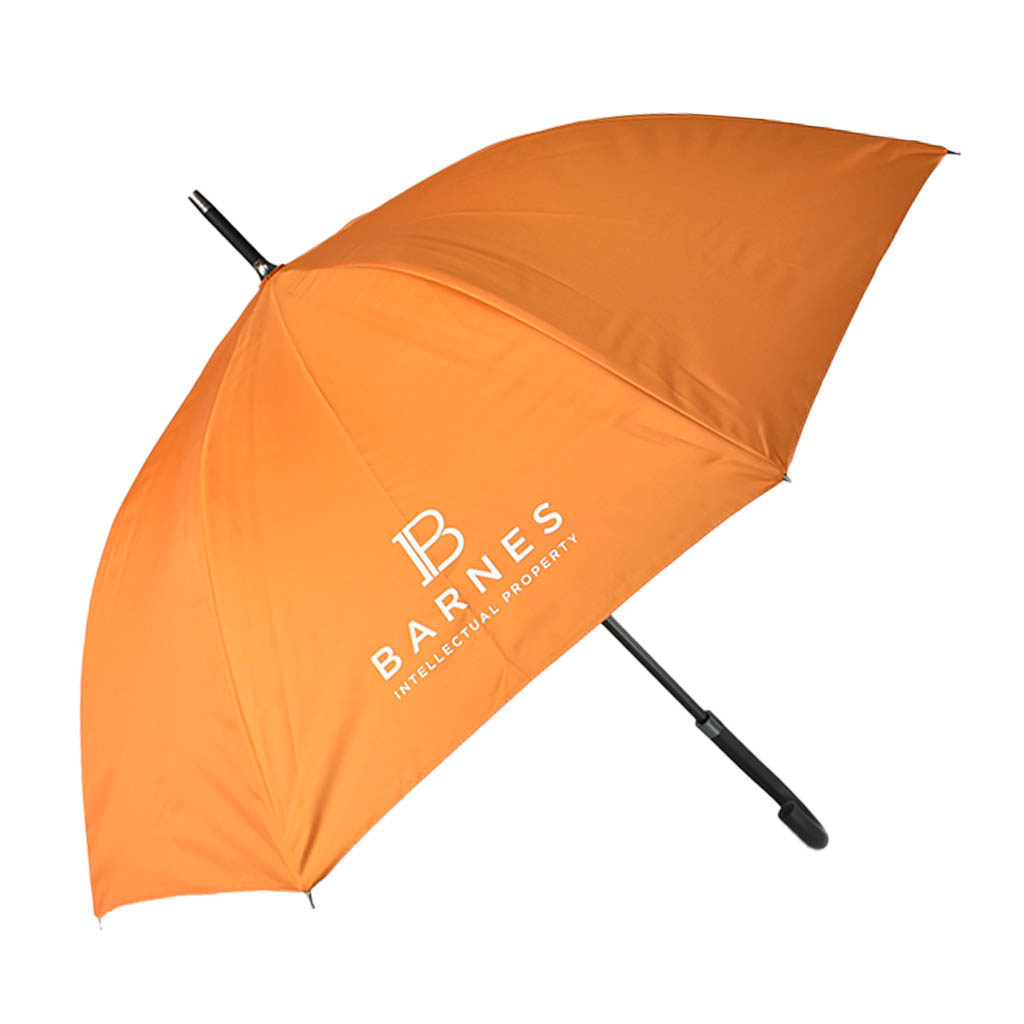

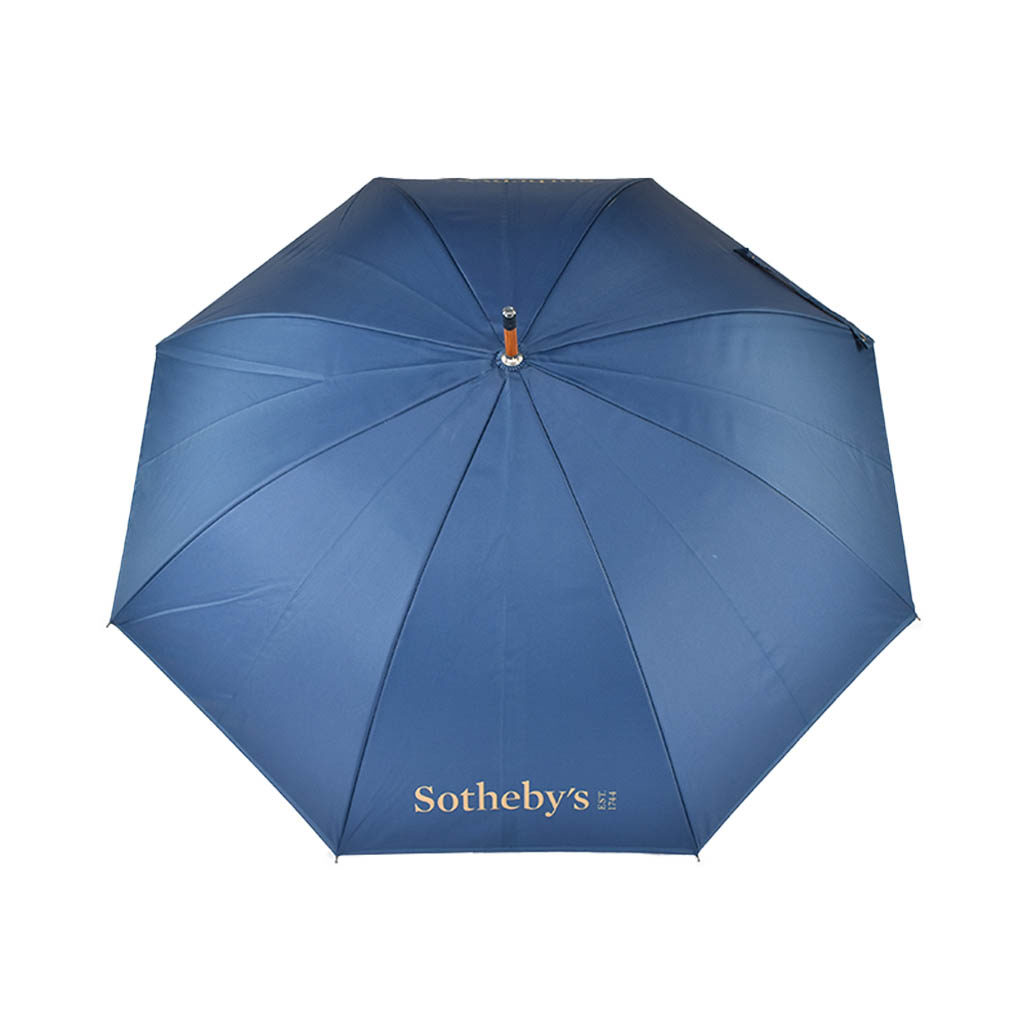

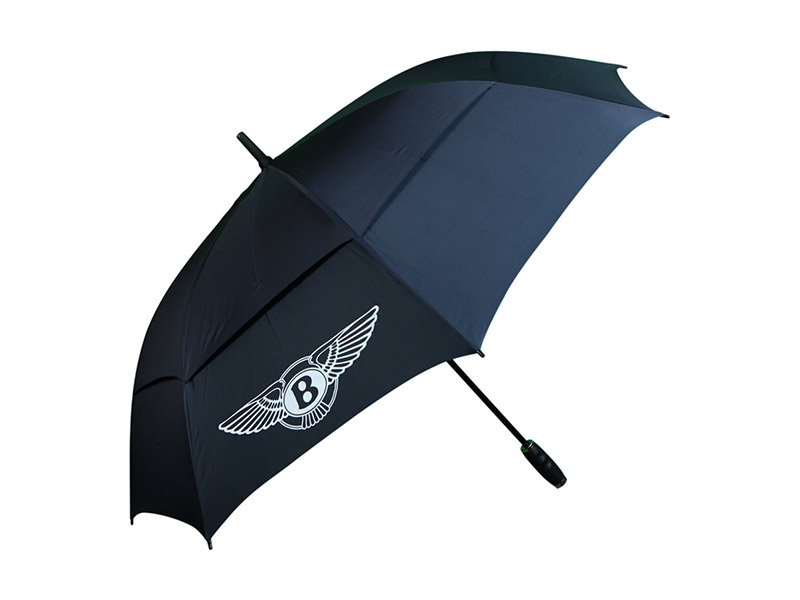

We build many of our umbrellas from scratch we are able to combine materials and effects to create truly unique design led umbrellas.
We can combine canopies to allow special effects, such as an under print to show through.
We can also combine materials such as printed PVC canopies and textile to amazing effect.
Tone on Tone effects can be achieved by harnessing the different properties of print and materials.
We are only restricted by your design brief, and we love push the boundaries of what can be done – bring us the challenge!!!


Or Fine Art Printing on Umbrella
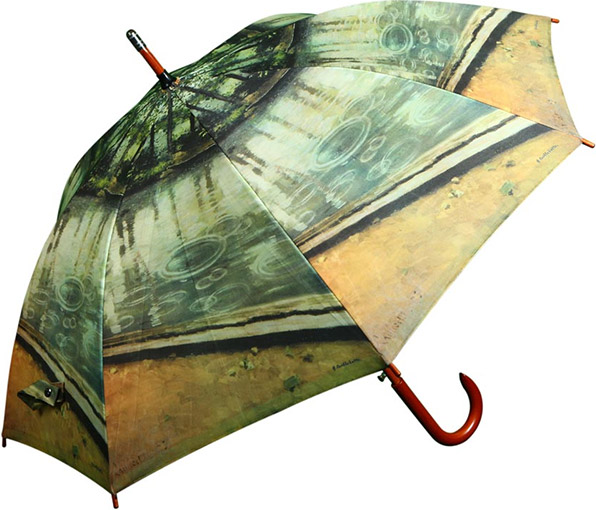

For fine art printing we have the ability of printing to a extremely high quality using a 4 colour print process used, specifically for reproduction of artwork and gallery pieces where dramatic colour and shading is required.
Fine art printing requires detailed reproduction of subtle colour differences and depth. This is a more expensive print process but allows immense depth of colour and detail.
The level of detail is incredible and we have printed a number of umbrellas for Museums and Art Galleries both in Europe and The USA.
We have supplied many fine art printed umbrellas to museums and galleries. We use specialist photographers who are used to working with fine art reproductions.
Umbrellas are a superb high value gift and souvenir, able to benefit from the unique assets of the organisation.
Embroidery & Sewing Effects
Umbrellas with embroidery on their sleeves can look amazing. Embroidery on the umbrella sleeve can be combined with traditional printing methods.
Most of the umbrellas we manufacture are made to measure, this means we make them from scratch to suit your requirements. That means we can offer a combination of decoration techniques to complete your design.
Our factories use the latest in computer controlled multi-headed embroidery machines. Woven labels or woven tags on umbrellas can add subtle branding to an umbrella often associated with premium brands. An embroidered label on an umbrella can appear on the outside and inside of the umbrella as well as on the umbrella sleeve.
We can offer a range of embroidery on umbrellas, from panel designs to tags, labels and sleeve decoration.
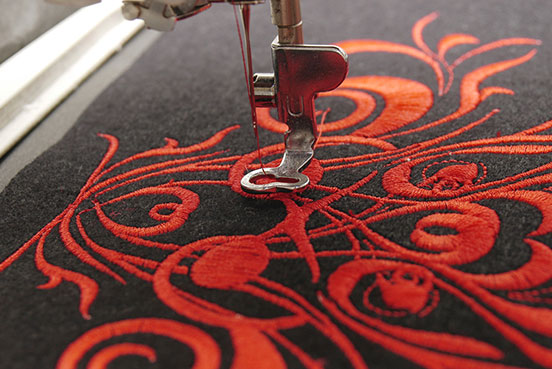

When it comes to creating a promotional umbrella that stands out from the crowd, our expert team excels at delivering fully customized solutions tailored to your exact specifications. With years of experience in the industry, we possess the knowledge and expertise to advise you on the best umbrella models and printing options that align with your brand identity and design vision. By utilizing high-quality materials and fabrics, we ensure that each promotional umbrella we produce is not only visually appealing but also built to withstand the test of time.
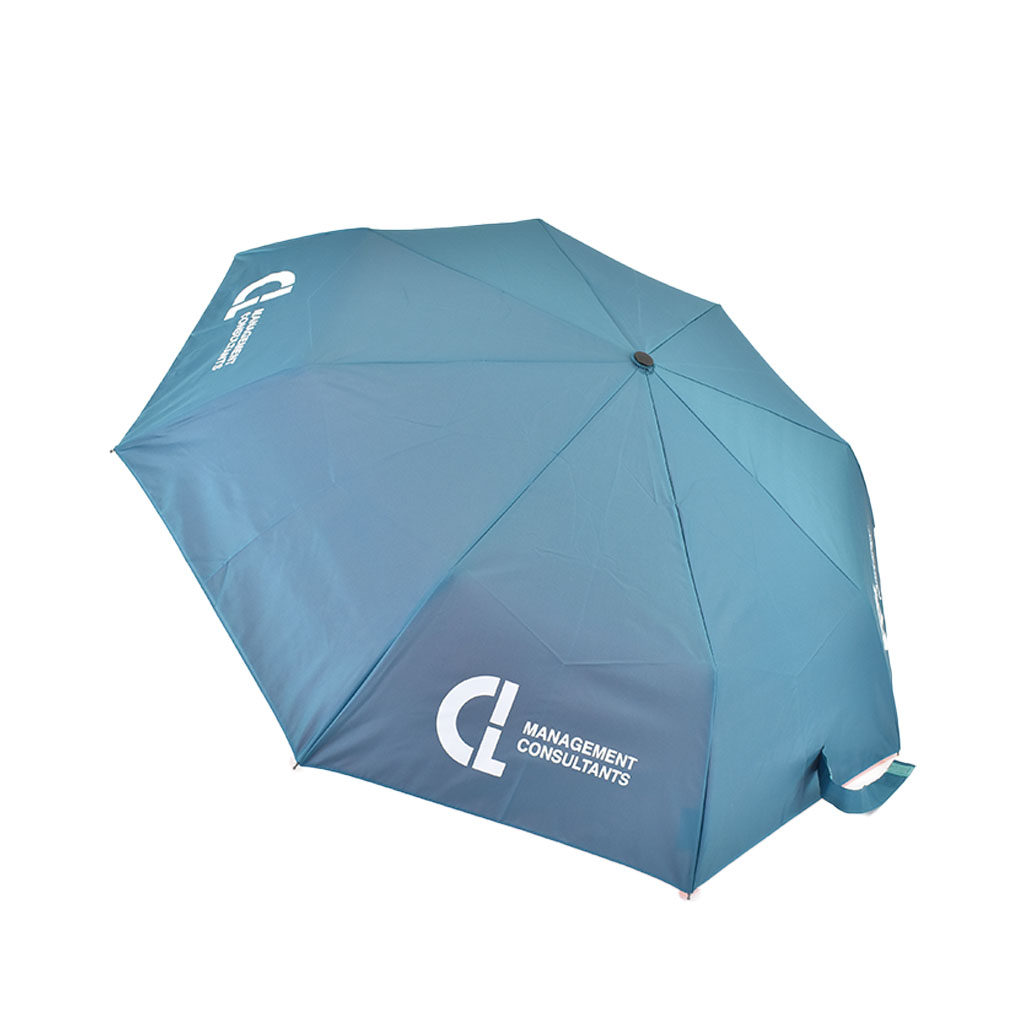




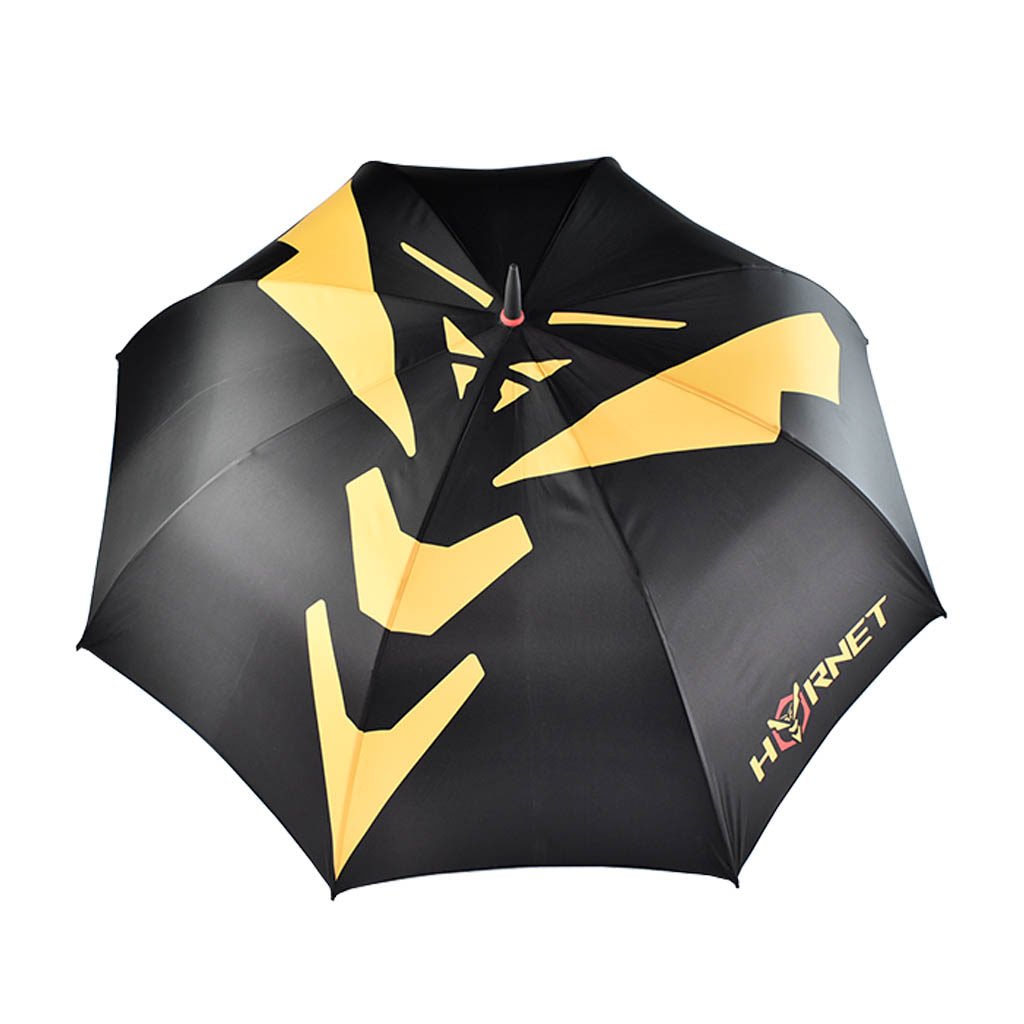

Step 1: Selecting the Perfect Frame
The first crucial decision in designing your promotional umbrella is choosing the ideal frame. Consider the desired aesthetic appeal, the intended purpose of the umbrella (e.g., event promotion, giveaway item, advertising medium), and even the type and color of the handle. Our team can guide you through the selection process, helping you find the perfect frame that compliments your brand image and captures the attention of your target audience.


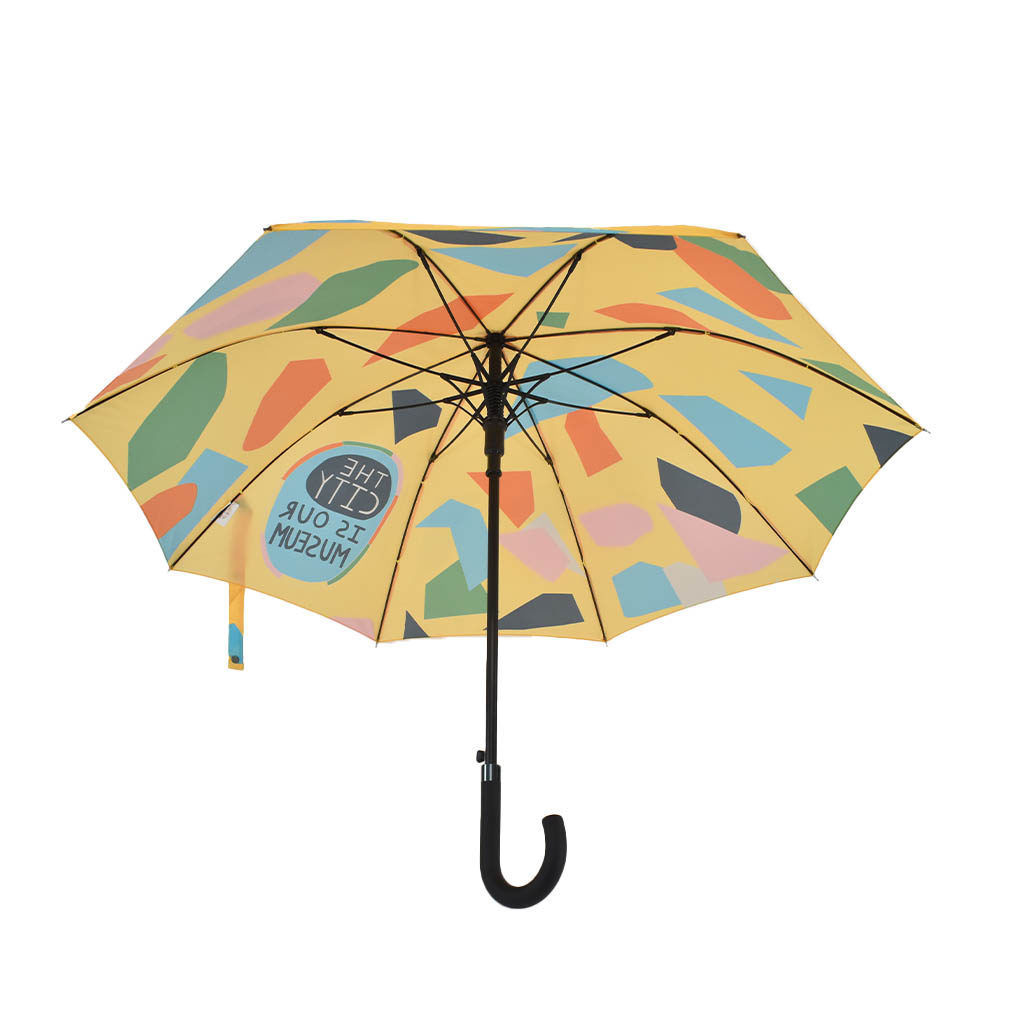

Step 2: Exploring Umbrella Print Options
Determining the most suitable print method for your promotional umbrella can be a daunting task, especially if you’re unfamiliar with the various options available. However, with our expertise, we can guide you through the process seamlessly. By carefully reviewing your artwork, we can recommend the most effective print method that will bring your logo and branding message to life. Considerations such as the number of colors you wish to incorporate and the possibility of color matching your umbrella canopy will all be taken into account to ensure a visually striking result.



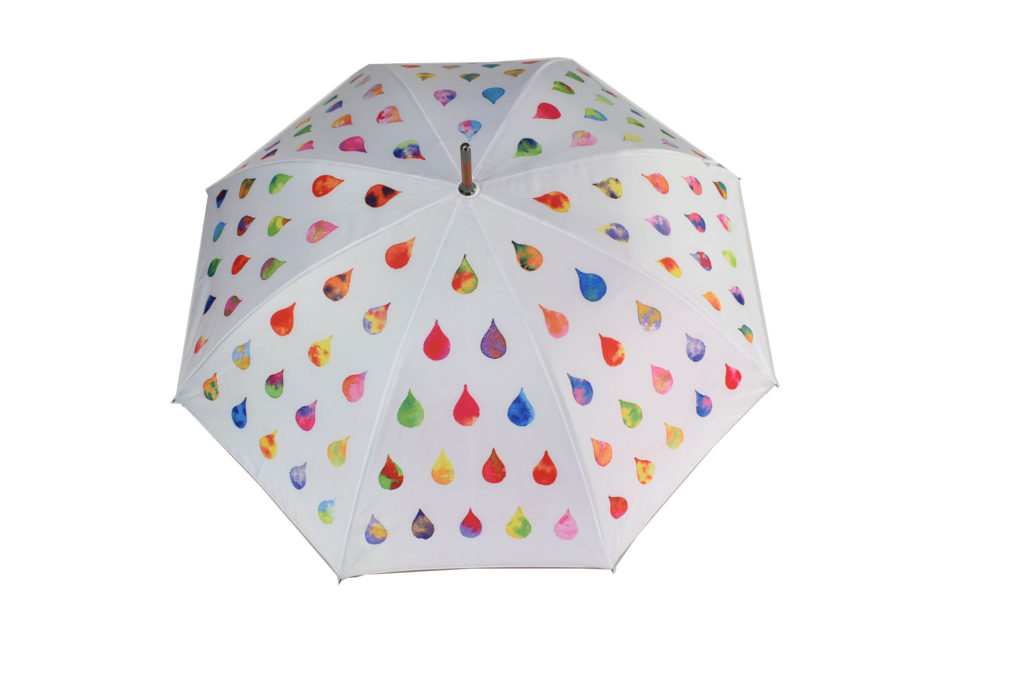

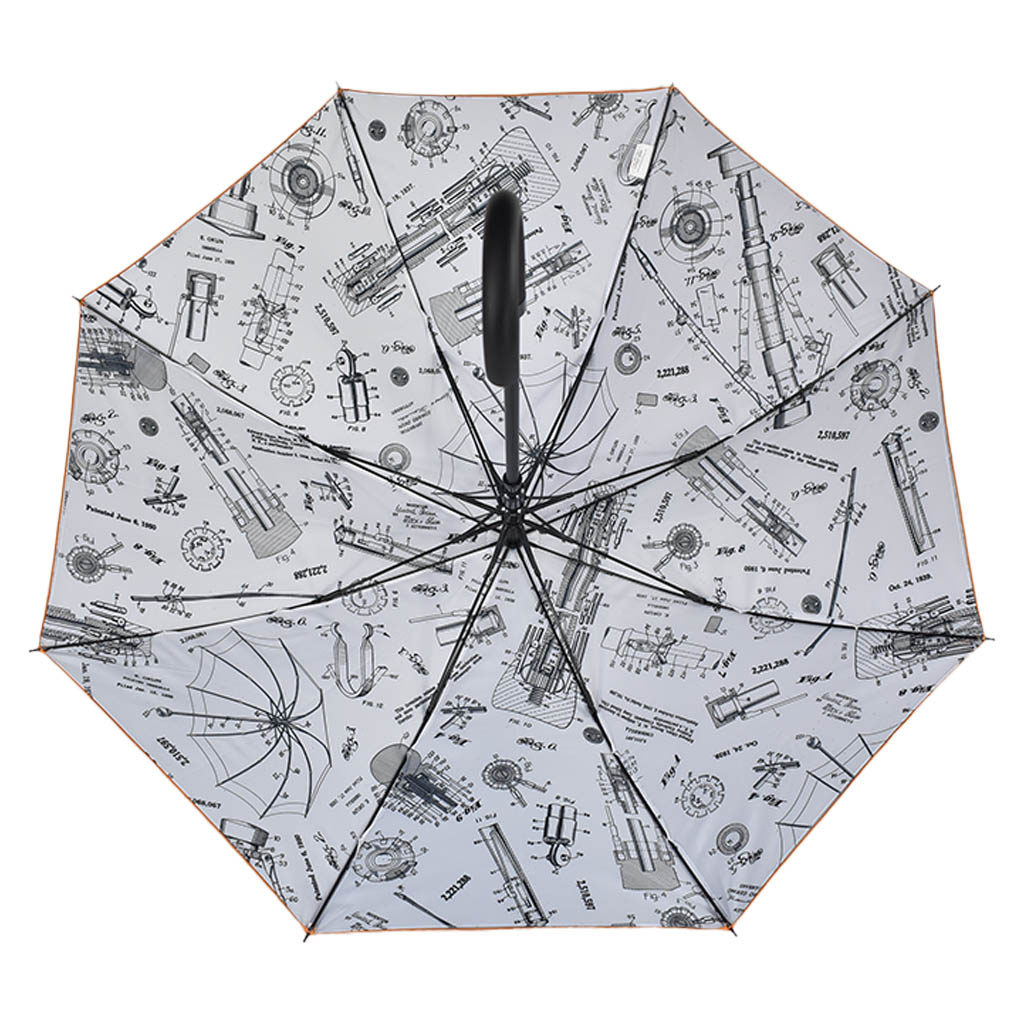

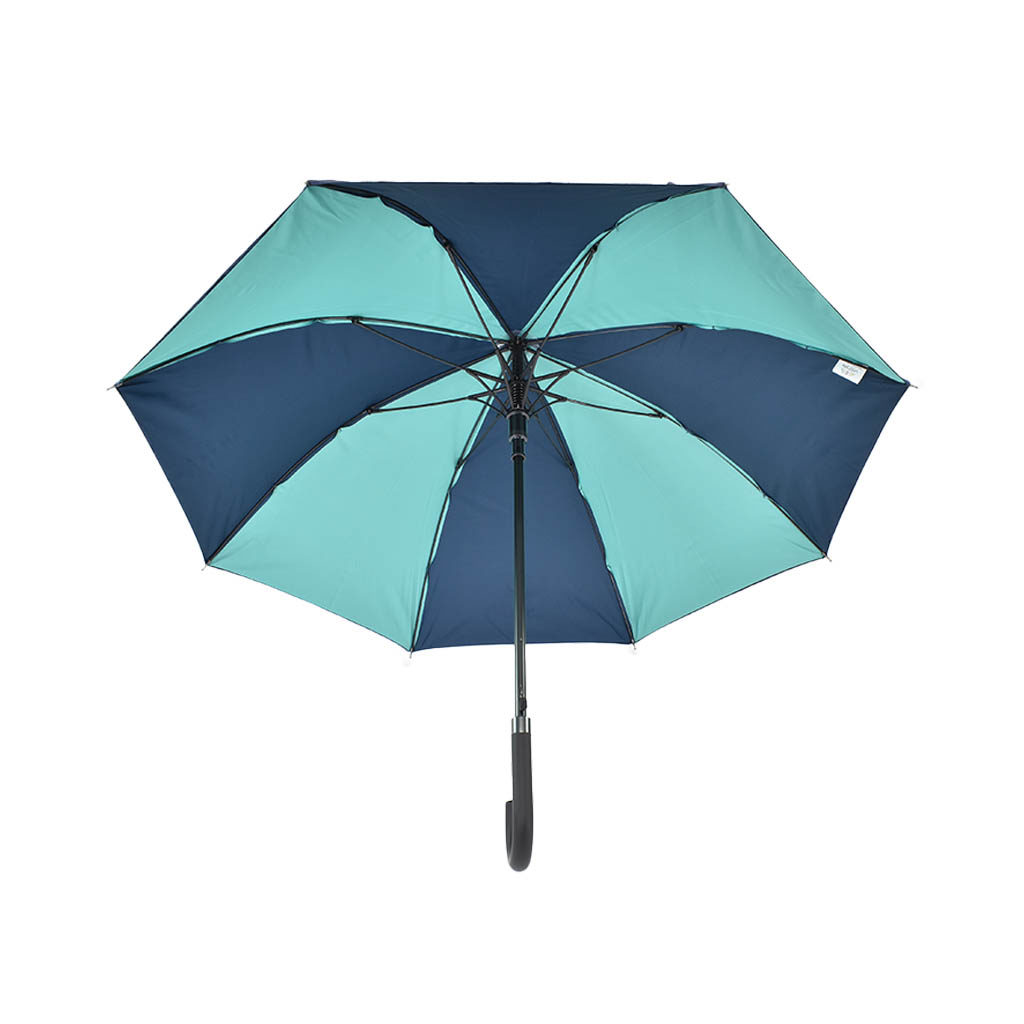

Step 3: Unleashing Customization Possibilities
To truly make your promotional umbrella a standout piece, we offer an array of customization options that add an extra touch of uniqueness. Features such as perimeter or rib tape, a printed tie wrap, or a printed sleeve with a handle are available to elevate the overall aesthetic and functionality of your umbrella. These customization choices provide an opportunity to reinforce your brand identity and make a lasting impression on your target audience.
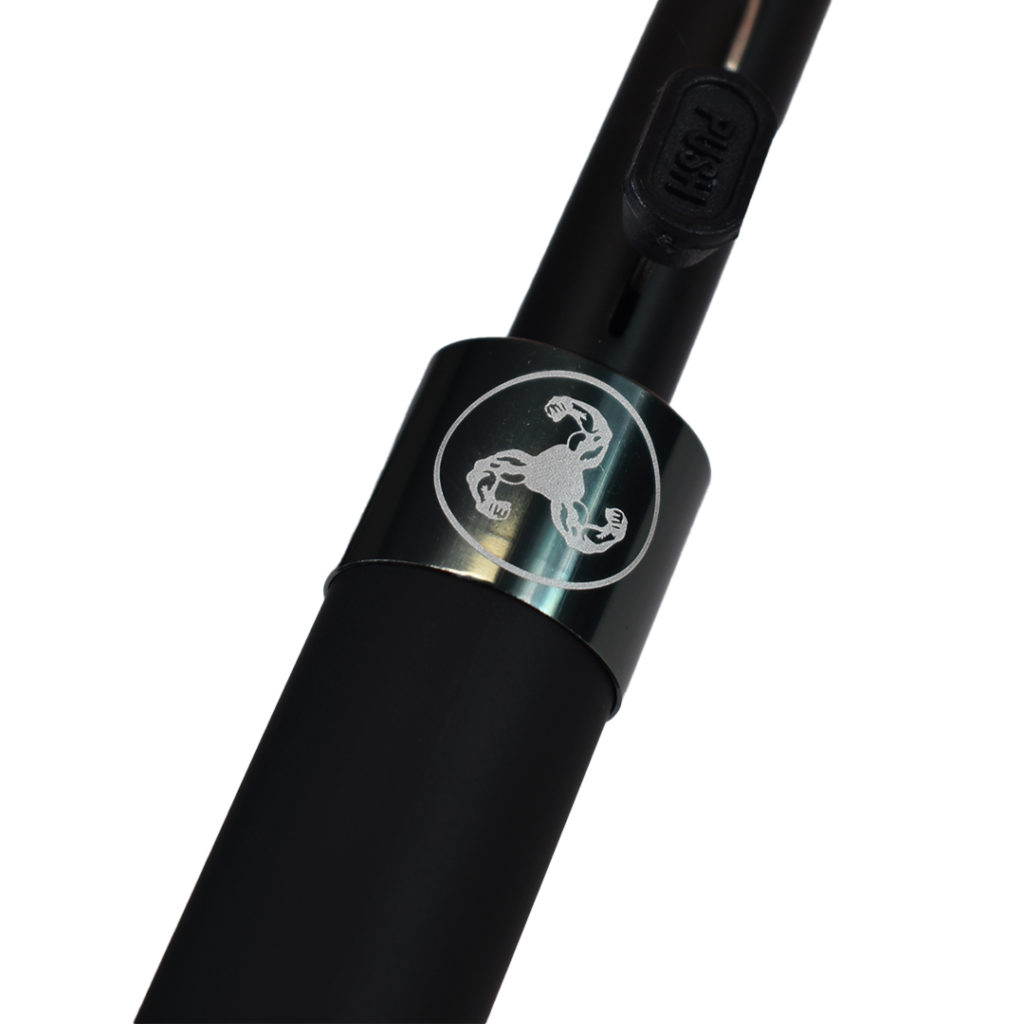

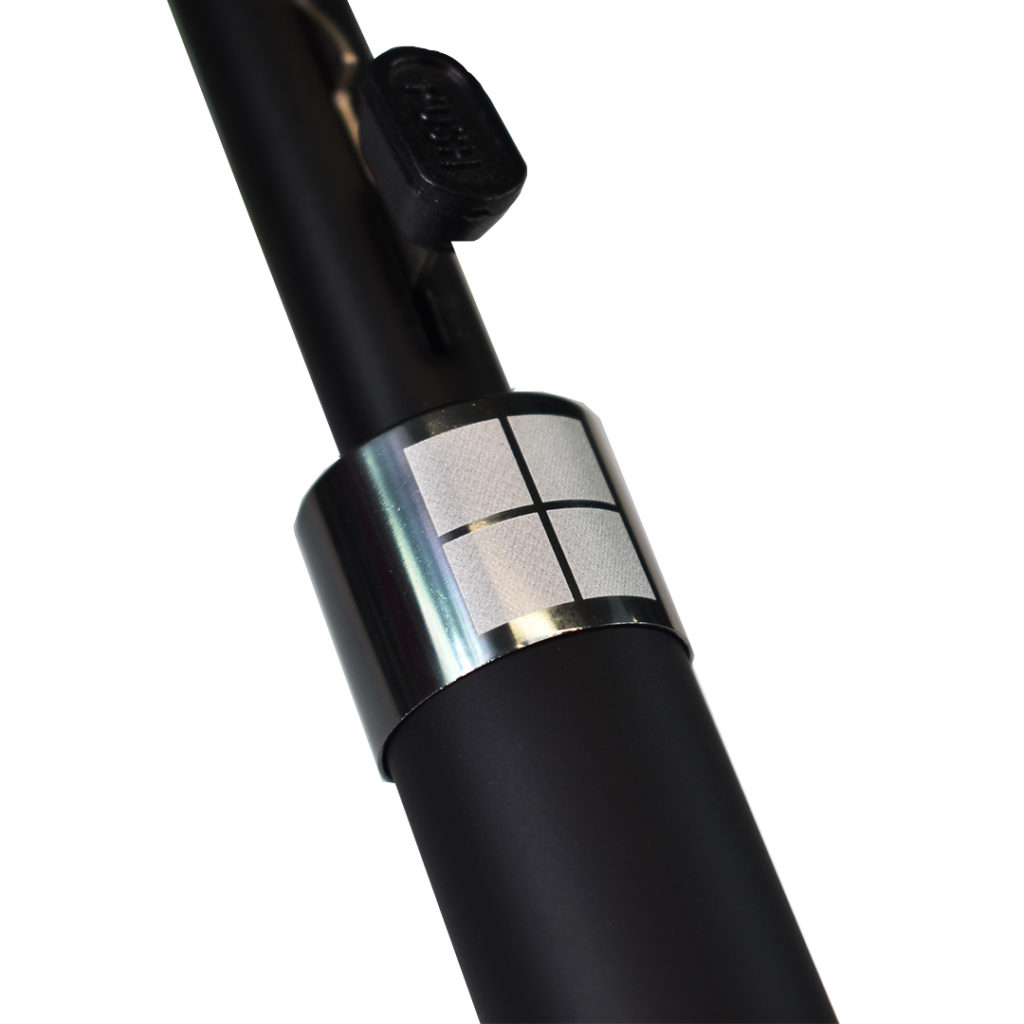

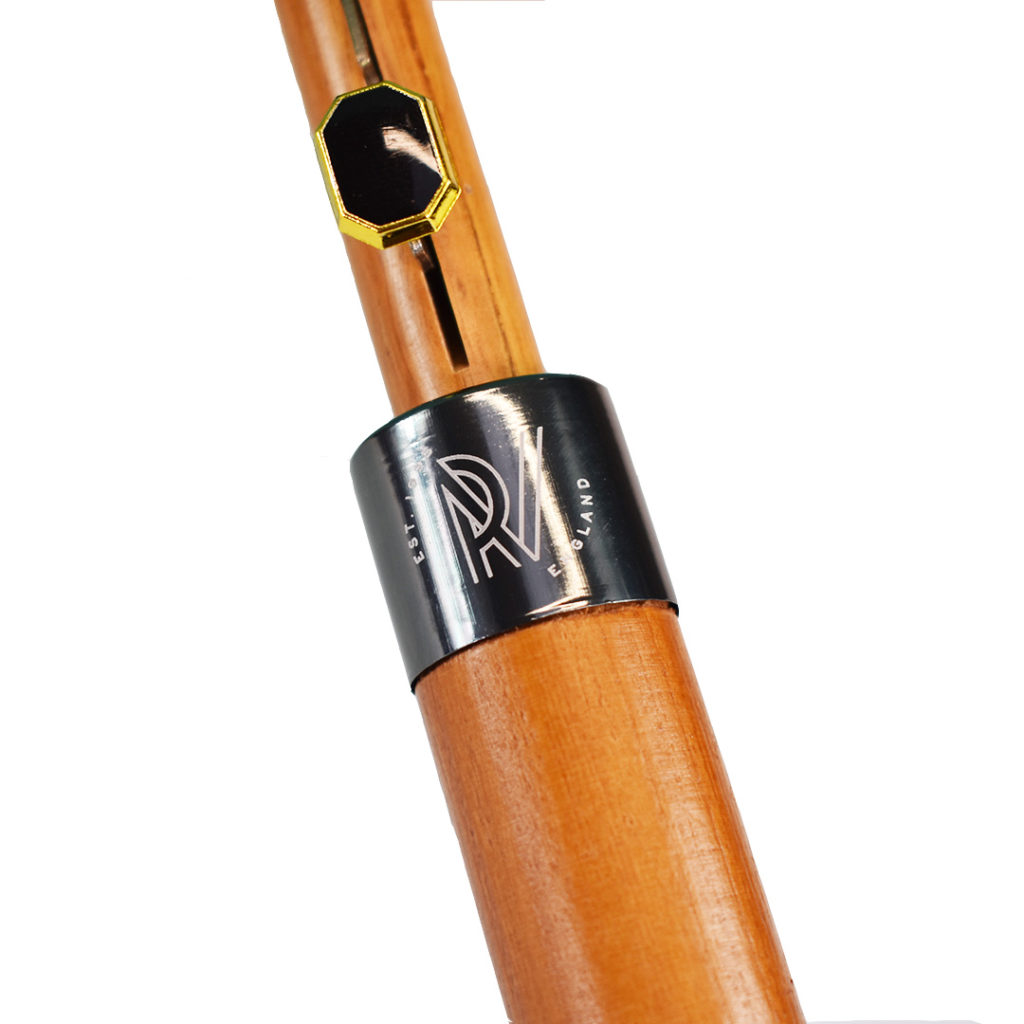

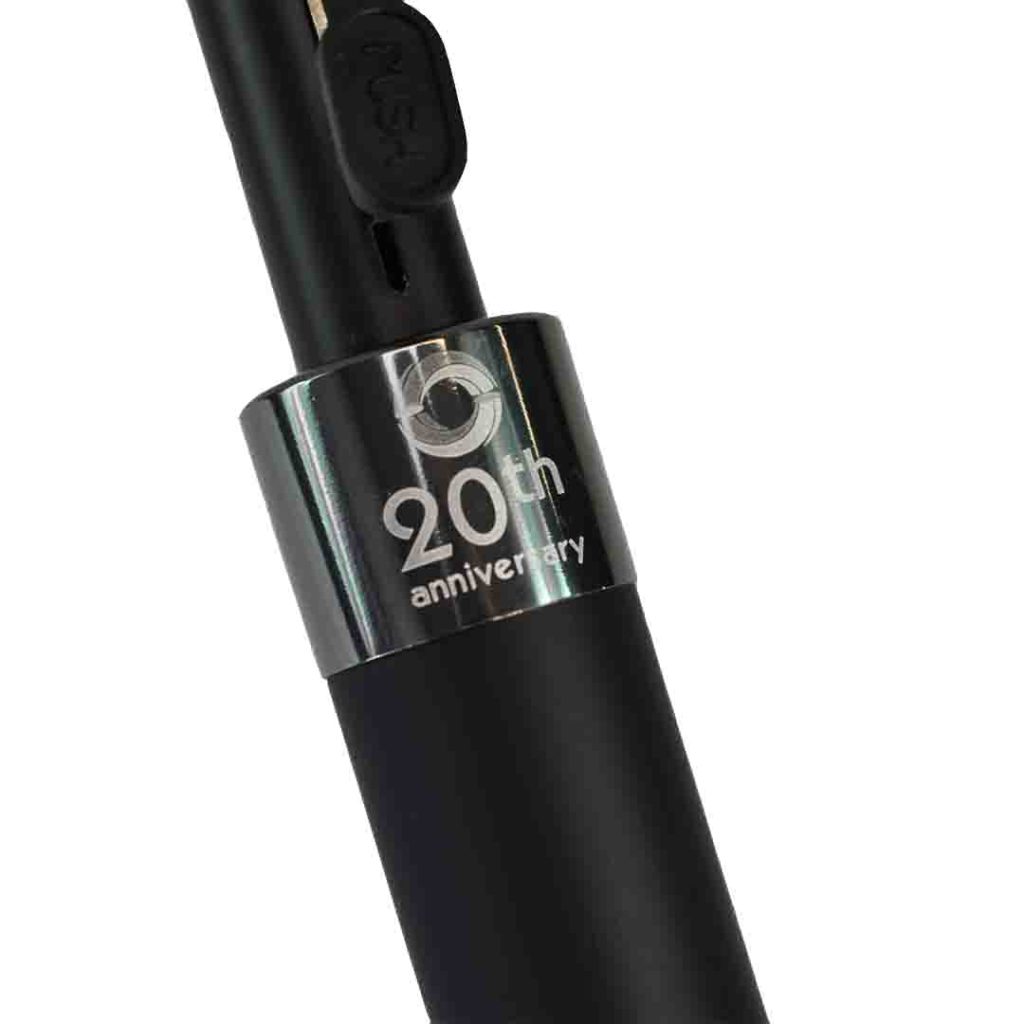

This traditional method of screen printing on umbrellas is highly effective and long lasting. An image is transferred to the umbrella surface by ink, which is pressed through a stencilled “silk” screen and treated with a light-sensitive emulsion. A screen is required for each colour to be printed.
The benefits of screen printing are as follows:
• Excellent reproduction of colour logos
• Cost-effective printing method
• Low cost origination
• Varnish print is available
The print size using this technique on ready made stock umbrellas is roughly A4 size. There is a restriction to not printing to the edge or close to seams.
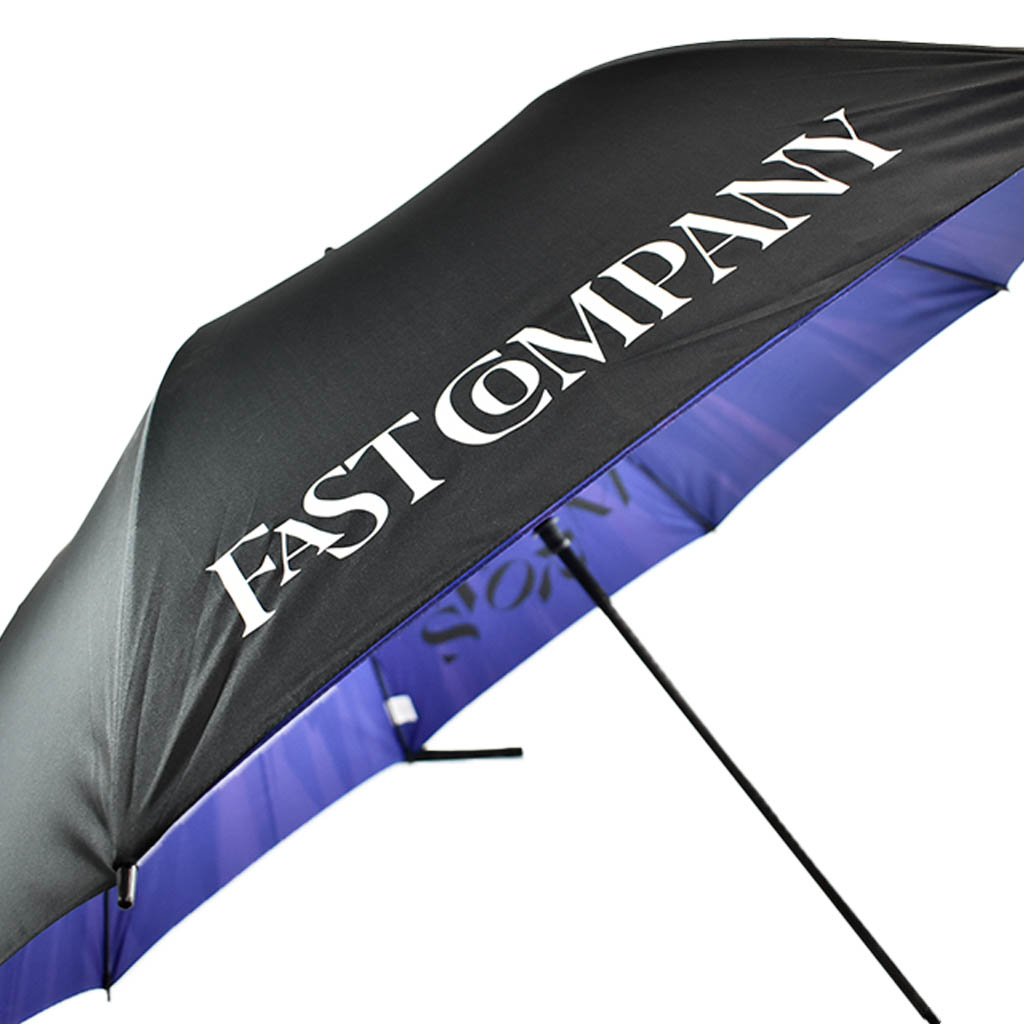

When we custom manufacture our umbrellas we can screen print the panels completely prior to sewing. This allows amazing effects such all over print and bold messages and branding.


Metallic printing on umbrellas is absolutely possible. We use a variety of inks and print effects for the reproduction of metallic logos and detailed metallic print on our umbrellas.
We don’t use gold coloured ink we use real gold! Our gold and silver inks contain tiny quantities of the base material, making the print iridescent.
We can also match this in with gold material for perimeter tape or inner panels as can be seen on the Mandarin Oriental luxury hotel umbrellas in the image.
Foiling is another superb method of decoration, where metallic foils are used instead of print. This is a more expensive process – but the effects are stunning. Foils come a large range of colours and textures.
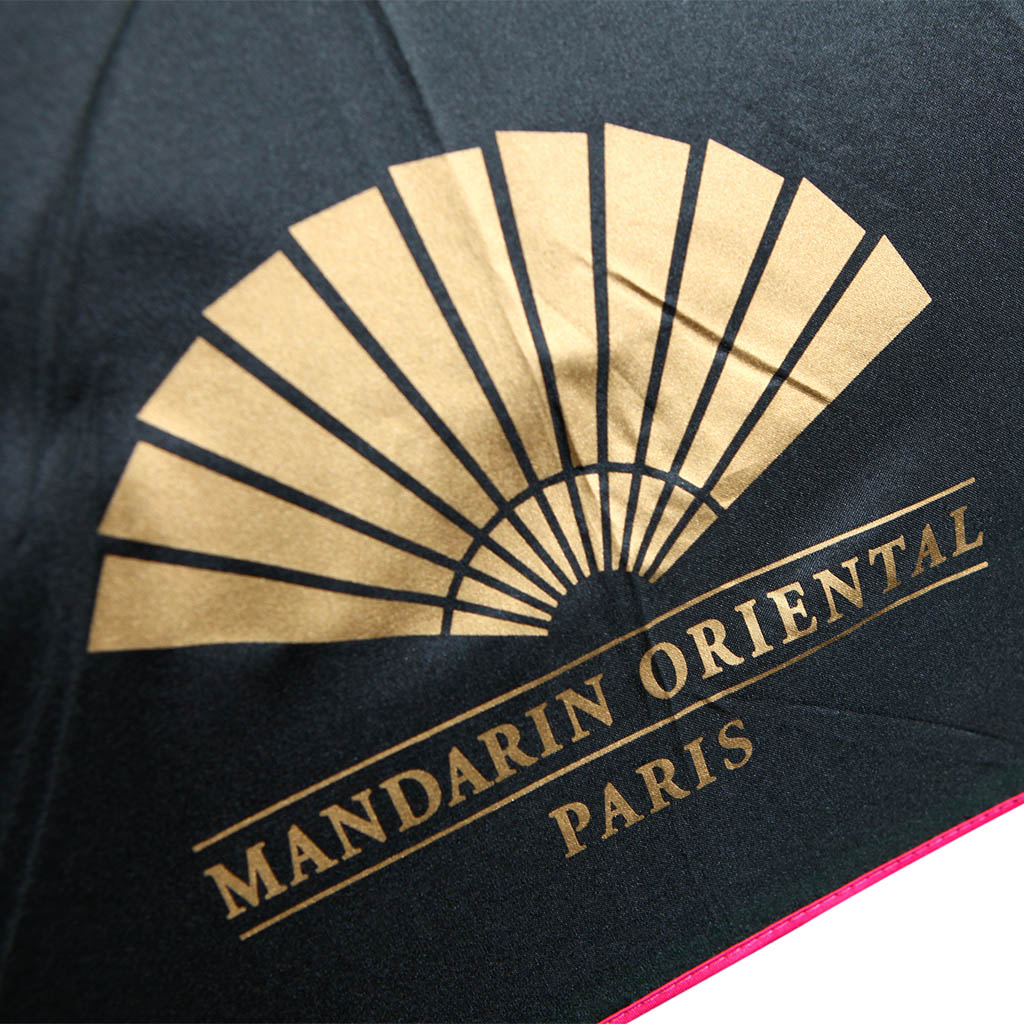

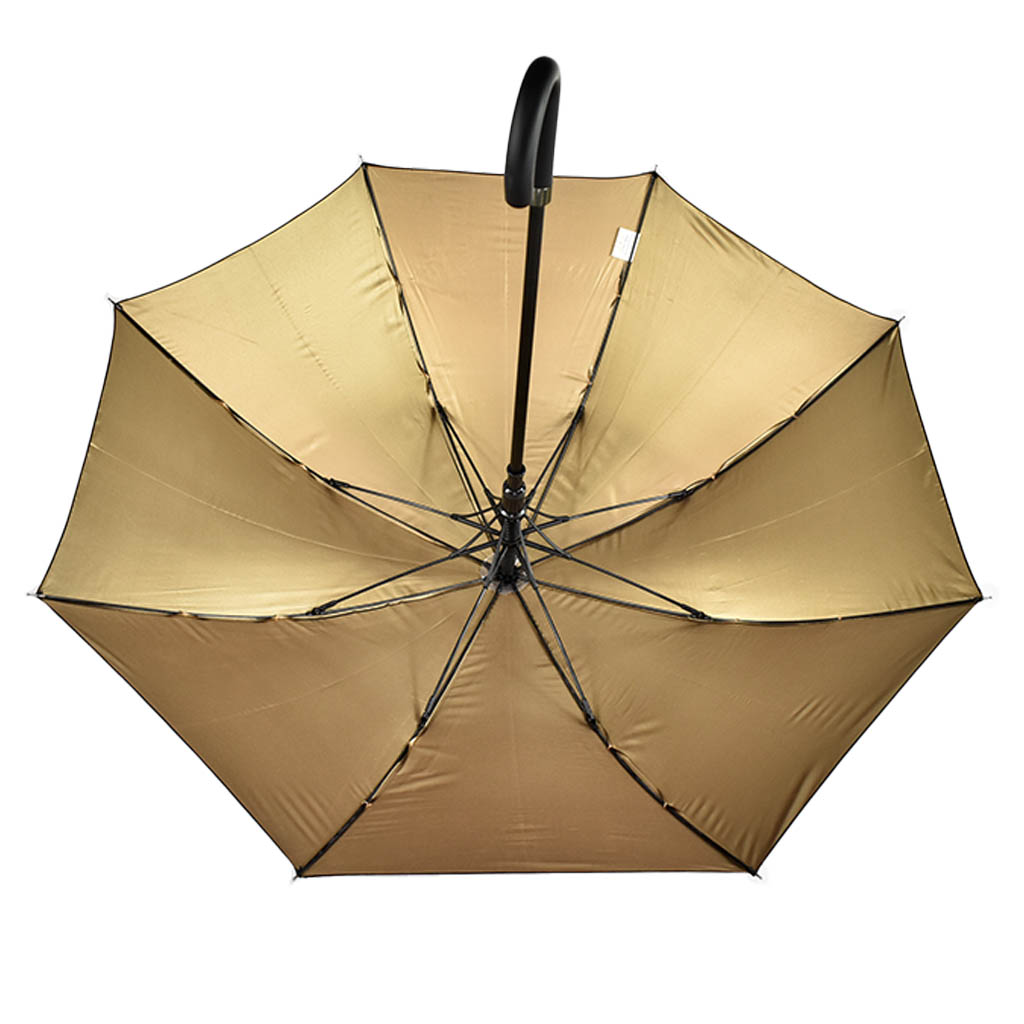

This low energy technology dramatically reduces the use of solvents in the printing process. It delivers a range of quality benefits including:
- Excellent print colour matches especially on dark fabric
- Remarkable level of detail for small text and intricate designs
- No limit to print colours possible
- Superb registration between print colours
- Striking reproduction of 4 colour process designs
- Environmentally friendly
- Smooth and even finish
